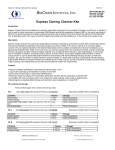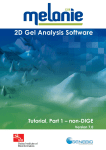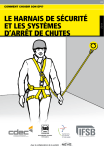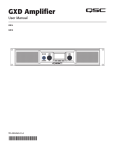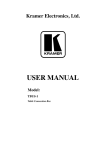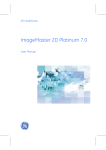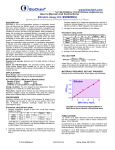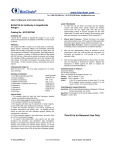Download Certificate of Analysis
Transcript
www.biochain.com Tel: 1-888-762-2568 Fax: 1-510-783-5386 Em ail: [email protected] User’s Manual and Instructions Express Cloning Checker Kits Catalog Number : K5011200 K5011200-1 K5011200-2 K5012100 K5012100-1 K5012100-2 K5013200 Introduction Express Cloning Checker kit enables you to perform large-scale screening of up to hundreds of colonies, in half a day. In addition, it can be used to check insert sizes in constructed cDNA libraries without the preparation of plasmid DNA. In the same way, plasmid DNA can be quickly analyzed b y directly using liquid bacterial culture, glycerol strain stock without the extraction of plasmid DNA. This is especially useful in the case of insufficient ligation generating very high background, or the cloning of very large inserts. Description Express Cloning Checker Kits provide two highly efficient methods of identifying recombinant colonies after transformation without time-consuming plasmid preparation. By using the large-scale screen method in Kit I, all you need to do is to transfer partial colonies of E. coli bacteria directly from the transformation plates into the solutions provided by the kits and immediately run an agarose gel electrophoresis. Within one to two hours, you will know exactly which are recombinant colonies, instead of spending two days using time and labor-intensive analysis methods such as plasmid DNA miniprep or colony hybridization. In case exact size or orientation of inserts is of special concern, there is a second choice. The enzyme digestion method of Kit II, in which a unique solution is used to release the plasmid DNA from host bacteria cells without affecting following reactions of restriction enzymes. So, one can perform a regular restriction enzyme analysis in a single tube by directly using bacteria without preparing plasmid DNA. With the combination of these two methods found in Kit III, one can use the first method to perform quick and large-scale screening in the expressway and use the second method to confirm the recombinants. Features · Rapid and efficient identification of recombinant colonies within 1 hour · Large-scale screening up to hundreds of colonies in short time · Quick check of insert sizes in constructed cDNA libraries · Restriction enzyme analyzing of recombinants directly from bacteria without preparation of plasmid DNA · Compatible with most commonly used E coli. bacteria from plate colonies, liquid culture or glycerol stock · Replacing time-consuming DNA miniprep and restriction enzyme digestions or colony PCR Kit contents and storage There are three types of kit. Check which kit you have. Kit I Cat # K5011200 (200 reactions) Previous Cat# 035301 Shipment condition: Room Temperature Contents Volume Storage Red solution Yellow solution Supercoiled DNA marker* (size: 3.0, 3.9, 5.4, 7.0, 10 kb) Screening plates 1.0 ml 1.0 ml 2 mg Room temperature Room temperature Room temperature 1 Room temperature F-753-3UMRevA K5011200& 2100&3200UA Active Date: 08312012 www.biochain.com Tel: 1-888-762-2568 Fax: 1-510-783-5386 Em ail: [email protected] Kit II Cat # K5012100 (100 reactions) Previous Cat# 035302 Contents Green solution Blue solution Kit III Volume 0.8 ml 0.2 ml Cat # K5013200 (200 reactions) Previous Cat# 035303 Contents Red solution Yellow solution Green solution Blue solution Supercoiled DNA marker* (size: 3.0, 3.9, 5.4, 7.0, 10 kb) Screening plates · Shipment condition: Room Temperature Storage Room temperature Room temperature Shipment condition: Room Temperature Volume 0.5 ml 0.5 ml 0.8 ml 0.2 ml 2 mg Storage Room temperature Room temperature Room temperature Room temperature Room temperature 1 Room temperature Supercoiled DNA marker has been freeze-dried for room temperature storage, add 20 ml sterile w ater and mix by vortex and spinning briefly several rounds before use. The resulted marker concentration is 100 ng/ml and should be stored at -20 °C. Brief protocol: A. Large scale screen method (Kit I and Kit III): 1. Pick up bacteria colonies and stir in 5 ml of Red solution. 2. Add 5 ml of Yellow solution. 3. Run gel and check results. B. Enzyme digest method (Kit II and Kit III): 1. Pick up bacteria colonies and stir in 8 ml of Green solution. 2. Heat at 100° C for 30 seconds. 3. Add 2 ml of en zyme mix and incubate at appropriate temperature for 30 minutes. 4. Add 2 ml of Blue solution. 5. Run gel and check results. Special notice for using the kit: · Use freshly prepared culture plates · Spread less 300 bacterial colonies per plate · Post-stain gel (no EB in gel and running buffer) · Add 20 ml sterile water in Supercoiled DNA marker tube and mix it before use. Store at -20 °C. Detailed protocol A. Supercoiled Plasmid Analysis (for Kit I a nd Kit III) After overnight culture (16- 24 hours) of transformation reaction: 1. 2. 3. 4. 5. Pour a 0.8 to 1.2 % agarose gel with thin comb (thickness less than 1 mm recommended). Do not submerge the gel in running buffer before sample loading. Mark 10 to 30 well separated colonies with numbers on the bottoms of transformation plates1. Add 5 ml of Red solution per well of screening plate supplied by the kit or micro-tubes. The screen plate can be used repeatedly after wash. Pick up partial bacterial colony2 (50 % to 25% if a colony size around 1.5 - 2.5 mm in diameter) of each selected colony with pipette tips. Stir attached bacteria 2 or 3 times into Red solution in wells or tubes from step 2. If the whole colony has been picked up, place the plate back to 37° C and incubate for a desired period after this step is done. Prepare DNA marker. a) Use supercoiled DNA marker provided in kit. Add 20 ml of sterile water into DNA marker and mix by vortex and spinning briefly several rounds before the first use. Take 2 ml of the marker and add it into 5 ml of Red 1 Use freshly prepared plates to culture bacterial colonies. To get well-separated and well-grown colonies, spreading of less 300 colonies per plate is recommended. Old bacterial colonies in plates, which are stored or cultured for several days, may produce weaker DNA bands. 2 T ake 1 to 3 ml of bacterial culture or plasmid stock strain instead of colonies if bacterial culture of a clone is available. F-753-3UMRevA K5011200& 2100&3200UA Active Date: 08312012 www.biochain.com Tel: 1-888-762-2568 Fax: 1-510-783-5386 Em ail: [email protected] 6. 7. 8. 9. solution. b). Use your own marker. Take 10 - 30 ng (in 2 ml volume) of vector DNA without insert and add it into 5 ml the Red solution. Add 5 ml of Yellow solution to each well or tube containing bacteria or DNA marker. Mi x samples by pipeting up and down 2 or 3 times and load them directly into loading wells of agarose gel3 before setting the gel in running buffer. Option: if using micro-tubes, but not supplied screening plate from step 3, one may load the samples in submerged gel in running buffer as an usual electrophoresis by following steps: 1) briefly mix samples after adding of Yellow Solutions; 2) add 4 ml of Blue buffer to each reaction; 3) vorte x samples for about 15 seconds before loading samples. These extra steps can increase target DNA signals and avoid defused bands generated from a none-fresh gel. So, it is only recommended to use if checking low-copy number plasmid clones or screening large quantity of colonies (more than 40). Set the gel with loaded samples in running buffer (1x TAE or TBE) and begin electrophoresis. Make sure running buffer gets into every loading well without bubbles. After the red dye band4 reaching 3-4 cm from loading well (cloning of small inserts less than 300 bp needs a little longer running), stop running and visualize the DNA by staining the gel in 0.2 - 0.5 5 mg/ml ethidium bromide . Examine the gel by UV transillumination. Due to low-copy number of plasmid DNA in some bacterial strain, photography of gel may need to use high aperture (4.5) and long exposure (2 to 5 seconds). Recombinant colonies will migrate slower 6 in the gel than the vector without insert . Now go back the original plates and select corresponding recombinant colonies to culture or stock for further analysis. B. Restriction Enzyme Digestion Analysis (for Kit II and Kit III to check size and orientation of inserts or restriction site information) Mark 10 to 30 well separated colonies with numbers on the bottoms of transformation plates 1. Add 8 ml of green solution in each microcentrifuge tube or wells of 96-well plate. Pick up partial bacterial colony2 (50% to 25% if a colony size around 1.5 - 2.5 mm in diameter) of each selected colony with small pipet tips7 and stir the attached bacteria 2 or 3 times into Green solution in tubes or wells from step 2. If the whole colony has been picked up, place the plate back to 37° C and incubate for a desired while after the step is done. 4. Heat the samples at 100 ° C for 30 seconds in boiled water or by using PCR machine. 5. After the samples cool down to room temperature, add 2 ml of digest mix containing 1ml of 10 x digest buffer and appropriate restriction enzymes (1 - 5 unit per reaction). 6. Incubate the samples at appropriate temperature for 10 - 30 min8. 7. Pour a 0.8 to 1.5 % agarose gel3 with thin comb (thickness less than 1 mm recommended). 8. Add 2 ml of Blue solution in each reaction and mix them. 9. Load samples in wells of the agarose gel. Finally, load linearized DNA size marker (not supplied in the kit) for DNA mobility comparison. 10. Begin electrophoresis in running buffer (1x TAE or TBE). Make sure running buffer gets into every loading well without bubbles. After the first dye (blue band) reaching about 3 - 4 cm length from loading well of the gel, stop running and visualize the DNA b y staining the gel in 0.2 - 0.5 mg/ml ethidium bromide4. 11. Examine the gel by UV transillumination. Due to low copy number of plasmid DNA in some bacterial strain, photography of gel may need to use high aperture (4.5) and long exposure (2 - 5 seconds). Now go back to the original plates and select corresponding recombinant colonies to culture or stock for further analysis. 1. 2. 3. 3 It is recommended to use freshly prepared gel (within 30 minutes after pouring off). Over-dried gel will generate diffused bands. Use 1.5% agarose gel if checking small inserts (less than 300 bp). 4 Red dye migrates through agarose gel slower than bromophenol blue at approximately the same rate as linear double-stranded DNA 1.2 kb in length. 5 It is strongly recommended using post-staining of gel and fresh staining buffer, which is made from EB stock solution. Adding EB in electrophoresis buffer or in gel will result in inconsistent migration of plasmid DNA. 6 There may be four bands observable (like lane 5, Fig 1) for each colony if picking up large piece of colonies and gel running time long enough. The fastest moving DNA bands, which are bigger than 2.5 kb, are strong and informative. Sometimes non-nucleic acid material and RNA will show up like diffused bands on bottom of gel, so comparison should be made between the informative bands of colony plasmid and that of control markers. 7 Avoid using of toothpicks to pick up colonies at this step because it absorbs the green solution. 8 Add more enzymes will shorten the incubation period. Over-incubation may result in digesting of genomic DNA and increasing background. F-753-3UMRevA K5011200& 2100&3200UA Active Date: 08312012 www.biochain.com Tel: 1-888-762-2568 Fax: 1-510-783-5386 Em ail: [email protected] Analysis of recombinant colonies with 1% agarose gel MC1 2 3 4 5 6 M 1 2 3 4 Fig 2. Enzyme digest analysis of the extracted plasmid DNA of these recombinant colonies in Fig 2 after minipreperation showing that they contains 0.9, 1.2, 1.7, 1.9, 2.2 and 2.5 kb insert respectively. At least 200 bp insert can be distinguished by the large scale screen method. Fig 1. Large scale screening analysis of recombinant colonies with different size of inserts which were demonstrated in lane 1 through 6 with comparison of the control vector without insert DNA (lane C, 5.4 kb). Lane M is Hind III/ lambda DNA marker. 1 2 3 4 5 6 7 8 9 10 M Fig 3. Large scale screening of recombinant colonies. Partial colonies were picked up directly from overnight cultured transformation plates and treated with red and yellow solutions before electrophoresis. Three recombinants with 2.5 kb insert (lanes 3, 5 and 8) are identified. Lane M is the supercoiled DNA marker supplied in the kit. kb 10 7.0 5.4 3.9 3.0 Recombinant Vector alone Chromosome DNA Vector Insert (838 bp) Insert (170 bp) 1 F-753-3UMRevA 2 M 5 6 3 4 Fig 4. Enzyme digest analysis of recombinant colonies. Recombinant colonies were picked up directly from overnight cultured transformation plates in green solution and followed by restriction enzyme digestion (Hind III/Xba I, lanes 1 and 2; EcoR I lanes 3 and 4) for 30 minutes at 37 °C. Lane M is Hind III/lambda DNA marker. M K5011200& 2100&3200UA Active Date: 08312012




